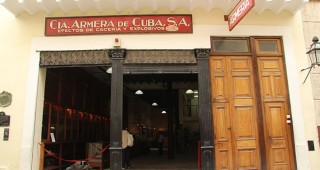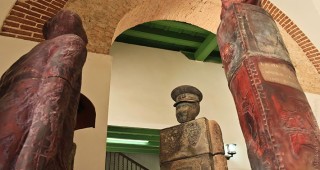Adjoining Fototeca on the square’s east side, the Planetarium is an interactive cultural center inaugurated on December 21, 2009. It provides a fascinating look into the origins and structure of the universe.
The museum occupies a giant atrium, four-floors high. At its heart, a coiling ramp loops up around 3-D representations of the solar system revolving around a giant sun, whose interior is a theater where visitors any of several high-tech shows, one of which takes visitors on a 45-minute ‘trip’ into outer space, including a visit to Halley’s comet, a number of planets and the Sun itself. The planetarium is also equipped with a telescope that can capture up to 6,500 stars; a library; a 3-D representation of the Big Bang, complete with imagined sound effects; a room for interactive games; and a staff of astronomers and physicists guides. Additionally, the Solar System Balcony offers a panoramic view from the top.
The Planetario is named in honor of Dr. Rosa Elena Simeón, former Minister of Science, Technology and the Environment, who conceived the idea in collaboration with City Historian Eusebio Leal. Construction was funded by the Japanese government and assisted by Japanese cosmologists.
Admission details: CUC 10 Guided tour
Opening hours: 10am, 11am & 2:30pm Wed-Fri; 10am, 11am, 2:30pm & 3:30pm Sat; 10am Sun. Box office half hour before show.
Plaza Vieja’s trip to the stars
By Victoria Alcalá
On January 20, 2010 Plaza Vieja received a new attraction, the Planetarium. This commemorated the 400th anniversary of Galileo Galilei’s astronomical discoveries and was helped with some Japanese funding. Exhibits include a scale reproduction of the solar system inside a giant orb, a simulation of the Big Bang, and a theatre that allows viewing of over 6,500 stars. The planets hang from the ceiling in which a section of the sky is shown by means of 2,500 orifices on the false ceiling. These are lit by means of seven types of optical fibres so as to achieve the different intensities of the celestial configuration, including Halley’s Comet, which was visible at that point in time, and a broad luminous band of light which contains the myriads of stars that comprise the Milky Way.
The usually lively Plaza Vieja in Havana’s Historical Center has an added attraction. Located in the former Habana cinema, a modern planetarium opened to the public on the 20th of January to commemorate the 400th anniversary of Galileo Galilei’s astronomical discoveries.
After the initial surprise caused by the façade in traditional style—which combines harmoniously with the atmosphere of one of the oldest plazas in the city—and the absolute contemporariness of the interior of the building, the visitors will find a three-dimensional representation of the solar system on a scale of 1:120,000,000 with the position exhibited by the planets in connection to the sun at 4:24 pm, on 21 June 1986. This configuration was chosen given its adjustment to the size of the room. The planets hang from the ceiling in which a section of the sky is shown by means of 2,500 orifices on the false ceiling. These are lit by means of seven types of optical fibres so as to achieve the different intensities of the celestial configuration, including Halley’s Comet, which was visible at that point in time, and a broad luminous band of light which contains the myriads of stars that comprise the Milky Way.
Besides the reproduction of the Solar System on the ground level, the visitors will be able to admire an exact representation—special effects included—of the event that is now generally accepted as having marked the beginning of the universe: the Big Bang. After the cosmic explosion, you climb a spiral ramp whose shape is very common in the universe and which has been conceived as a scale in which each step means vast stretches of space in the history of the universe until you reach the star that dominates the planetary system: the Sun. This luminous celestial body measures 11.65 meters in diameter and its fibreglass surface reproduces the intensive solar activity of August 1972, symbolic date that marks the beginning of scientific work on solar astrophysics by future Cuban astrophysicists, who had just earned their undergraduate degrees from the University of Havana. The 65-seat planetarium theater is located inside the Sun or Space Theatre, where, thanks to the state-of-the-art Japanese equipment, visitors are able to observe 6,500 stars, constellations, meteor showers and other celestial phenomena. Lectures, film showings and theatrical shows are also anticipated.
The second level holds the Cosmonautics and Space Technique Hall, which illustrates the relationship of man with space from the very beginning of time to the present day. The Stellar Hall and the Galactic Hall are both on the third level of the building, as well as the Solar System Balcony from where visitors can see, from atop, the system that they saw above their heads when they entered the building. On the fourth level you find an open—air Observatory with telescopes fitted with special filters that enable you to watch directly at the sun. In the case of significant space phenomena, the Observatory will open in the evening.
Created as a cultural center for science and technology, the Planetarium intends to go beyond the mere contemplation of heavenly bodies. The main purpose of its directors is to make available to the public in general, and children and youths in particular, the immense wealth of knowledge in disciplines such as astronomy, mathematics, physics and exobiology. The institution relies on the expert advice of the distinguished Cuban astrophysicist Dr. Oscar álvarez Pomares, a well—known figure on television thanks to his commentaries of documentaries on the origin of the universe, space travel, the formation of galaxies or the controversial issue of extraterrestrial life.
In less than two weeks’ time, hundreds of men, women and children have visited the Planetarium—the younger crowd excited about seeing a show of this nature for the first time (the other public planetarium in Cuba is in the province of Sancti Spíritus and its technology dates back to the 1960s), while the older generations of Cubans can’t help feeling a bit nostalgic when they recall the old planetarium in the Capitolio Nacional. And although the Havana Planetarium doesn’t bear comparison with the large—scale planetariums of the world, whose domes are over 20 meters in diameter, this is an excellent opportunity to take a look at the mysteries of the universe from the oldest part of the city.


















 Eclectic
Eclectic






